Hiroshima okonomiyaki and hungry deer, conger eel and grape soft serves on Miyajima Island
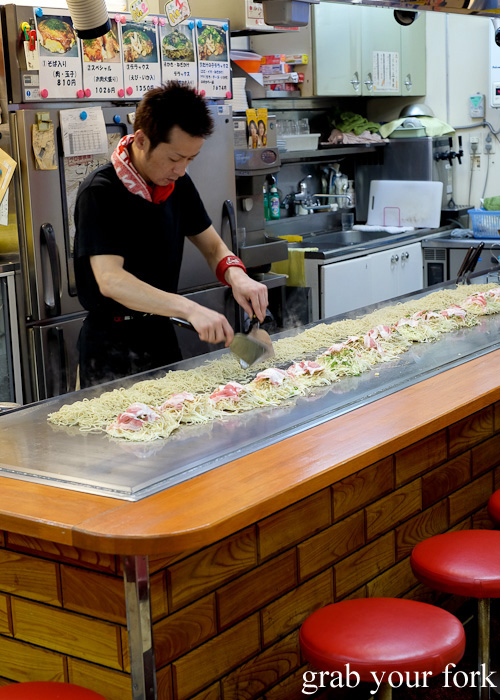
"He's eating my itinerary!" There was a wild and shrieking panic as we ran after the deer, already swallowing the first sheet of racy_staci's bundled papers. We'd laughed at everyone else's stories of Miyajima deer eating maps out of people's hands - oh those silly people - but that didn't lessen the shock when it happened to us, the deer sneaking up behind our backs and then quietly and efficiently removing the stapled pages from a handbag pocket. We were outraged and indignant, chasing him to retrieve what we could. But even as we ran, we were lethargic, our bodies sweating in the humidity and our bellies still full from a day that began with a mountain of hiroshimyaki, the okonomiyaki pancake served Hiroshima-style.
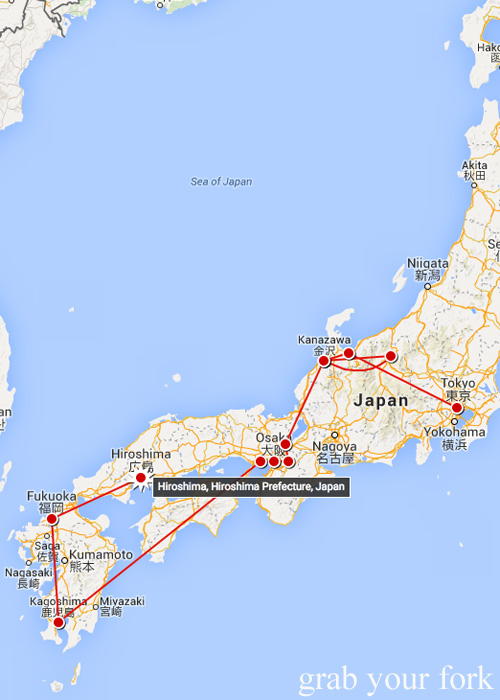
Our Japan travels that started in Tokyo
The beauty of the JR pass is the ability to do random day trips, perfect for fitting in new stops even after you've booked all your accommodation. And so even after we'd left Honshu Island and made our way down to Kyushu, we back-tracked from Fukuoka to Hiroshima for a day trip, a 70-minute journey by shinkansen.
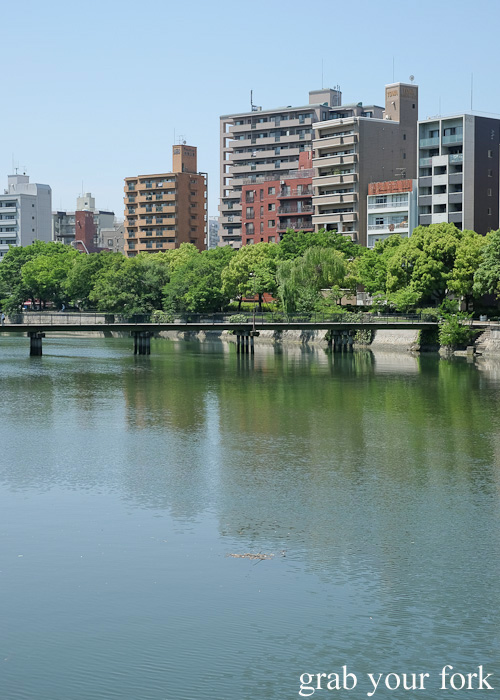
Bridge across the Ota River in Hiroshima
I'd been to Hiroshima twice before, and so while half our group split off and explored the Hiroshima Peace Memorial, Museum and Sadako's paper cranes, the rest of us walked in the shimmering heat to the city centre for an early lunch.
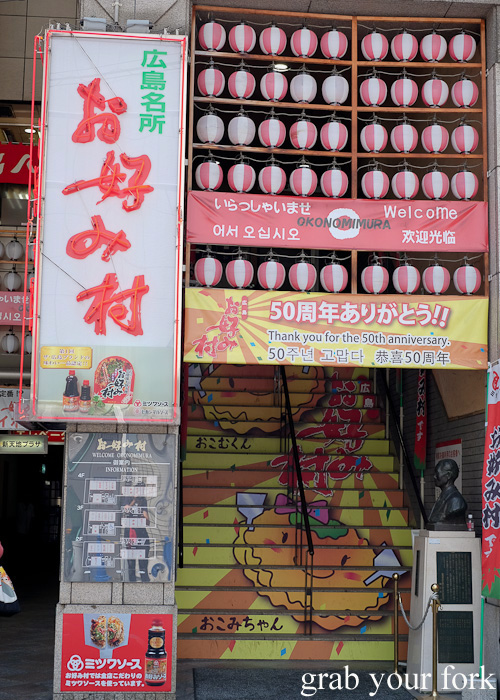
Entrance to Okonomimura
Okonimura is probably one of the most touristy places you can eat at in Hiroshima, but it's one of the easiest ways to try hiroshimayaki, the local take on the Japanese national dish of okonimiyaki, a pancake made with cabbage and other fillings.

Stalls at Okonomimura
Okonomimura translates to okonomi village, an apt description for the 25 stalls spread over three floors of this towering building. You can take the stairs or the lift, depending on how many calories you want to expend before you eat them again.
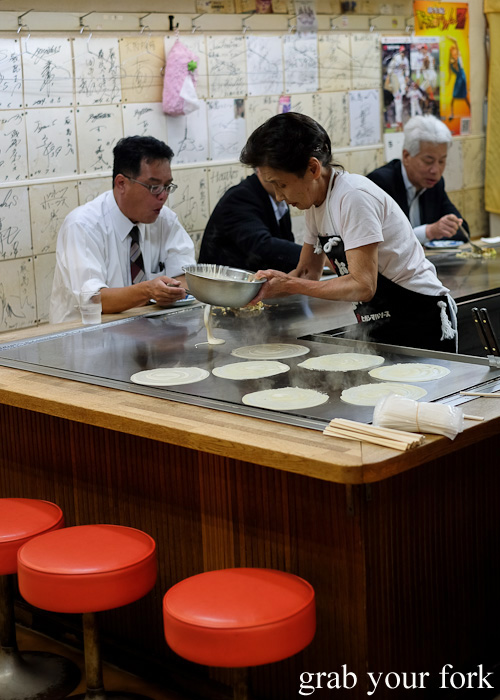
Customers eating at the okonomiyaki counter
Each stall claims to have a unique specialty, although the dizzying onslaught of Japanese characters - few have English signs but many will have a hidden English menu - mean that you'll probably just gravitate towards the first one that catches your eye.
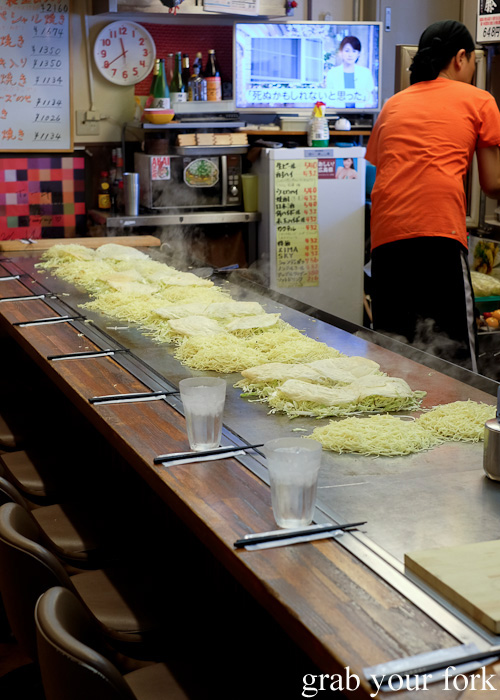
Hiroshimayaki being prepared for student groups
On a early weekday lunch, we were surprised to find so many stalls already cooking an army of okonomiyaki pancakes even though no customers had arrived. We later realised they were preparing for the onslaught of school kids on excursions, about to enter any minute.

Watching our chef ladle okonomiyaki batter
We choose a random stall, swayed by the chef's cheerful smile and friendly - but not overly desperate - demeanour. A row of bright red stools line the L-shaped grill, giving you an uninterrupted view of all the action.

Layering the cabbage and bean sprouts, hiroshimayaki style
What's the difference between okonomiyaki, and hiroshimayaki? Okonomiyaki mixes all the pancake ingredients together in a batter before cooking, whereas hiroshimayaki layers all your ingredients separately on the grill.
I find that hiroshimayaki is more textural and less soggy. Where okonimyaki can sometimes come across as being a bit gluggy or an indistinguishable mish-mash of everything, hiroshimayaki provides distinct layers of ingredients that aren't encased in pancake batter.
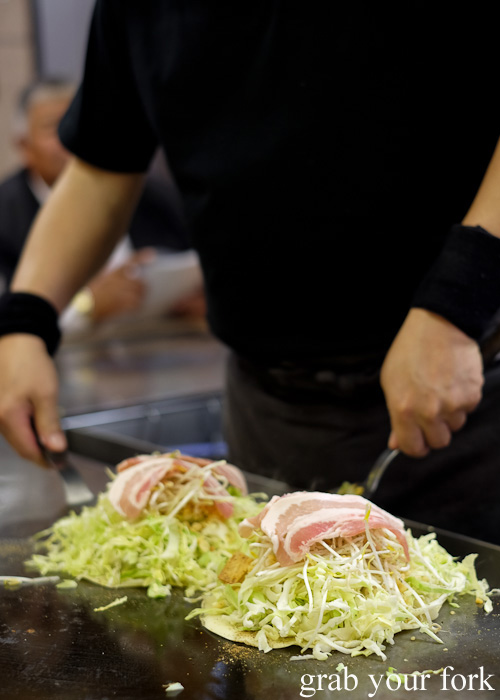
Adding bacon rashers to our hiroshimayaki
The layered construction means we can watch everything added one by one, crowned with a luscious curl of streaky bacon.
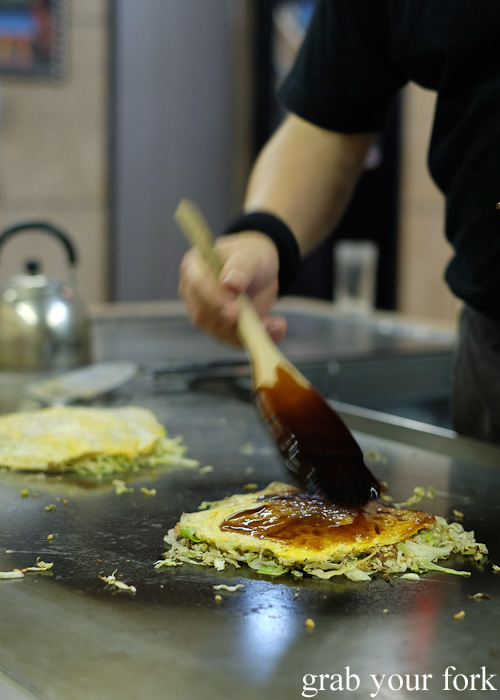
Brushing on the okonomiyaki sauce
A fried egg forms the top layer of the hiroshimayaki pancake. The springy mattress of cabbage cooks down and is flattened. The chef brushes a thick layer of fruity okonomiyaki sauce across the top.
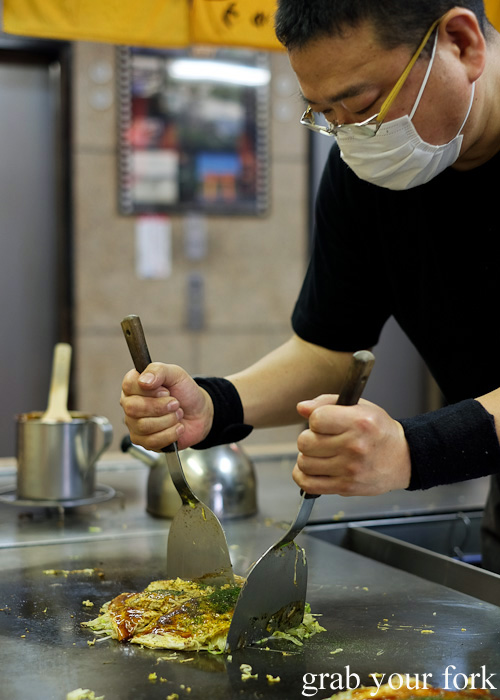
Cutting up our hiroshimayaki
It only takes a few minutes before our hiroshimayaki pancake is ready, cut into nine squares with metal spatulas for easy eating.
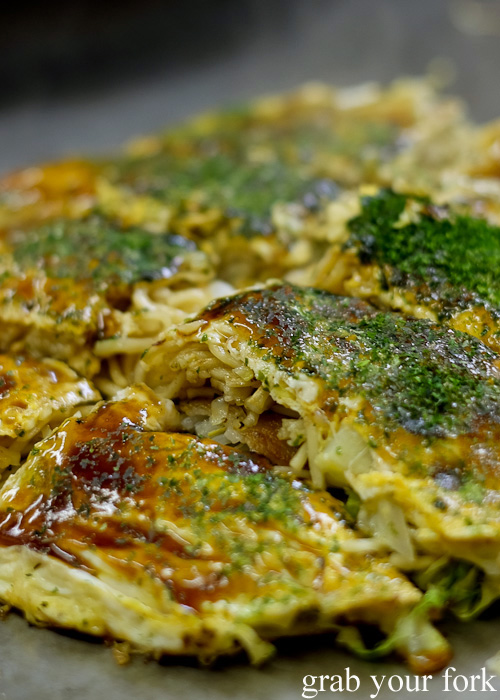
Hiroshimayaki with pork, vegetable, egg, Chinese noodle and shrimp 1134 yen / AU$12.50
We transfer portions of hiroshimayaki straight off the heated grill and onto our plates. The basic okonimyaki with pork vegetable and egg starts at 702 yen or about AU$7.70. To one, we'd added Chinese noodles and shrimp. The prawns, while few, are large and sweet.
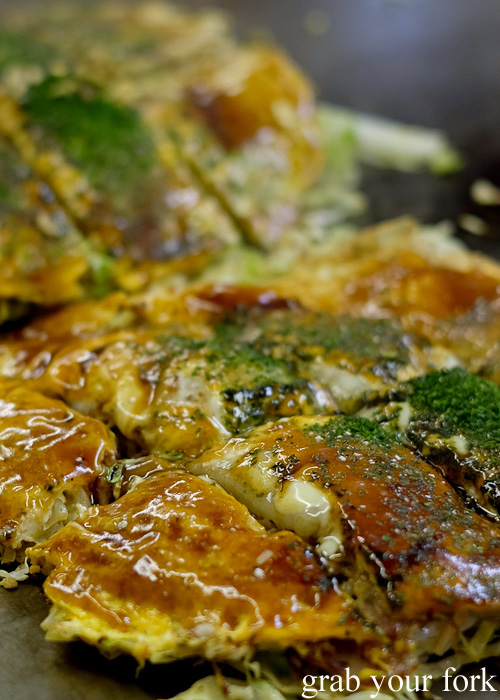
Hiroshimayaki with pork, vegetable, egg, rice cake and cheese 1026 yen / AU$11.30
On the other, we'd added rice cake and cheese. This one is my favourite by far, with hidden jackpots of chewy glutinous rice cake and then molten rivers of gooey cheese. The dusting of seaweed flakes across the top adds an umami addictiveness.
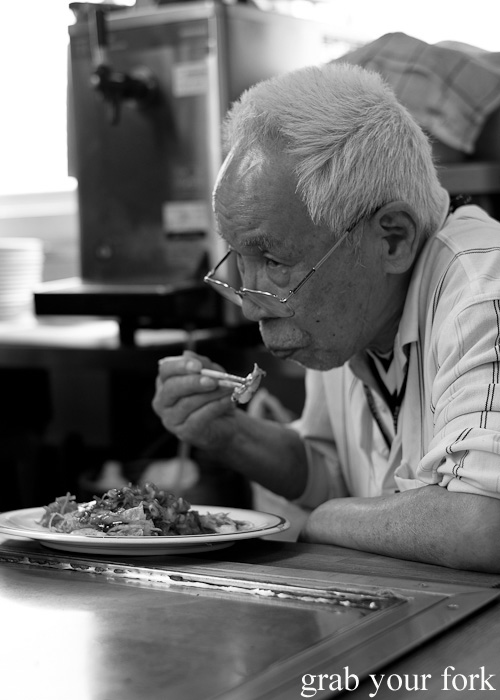
Local okonomiyaki fan
It's a fun and social affair, perfect for eating with a schooner of beer and making friends with the locals. We were so full afterwards, we unashamedly took the lift downstairs.
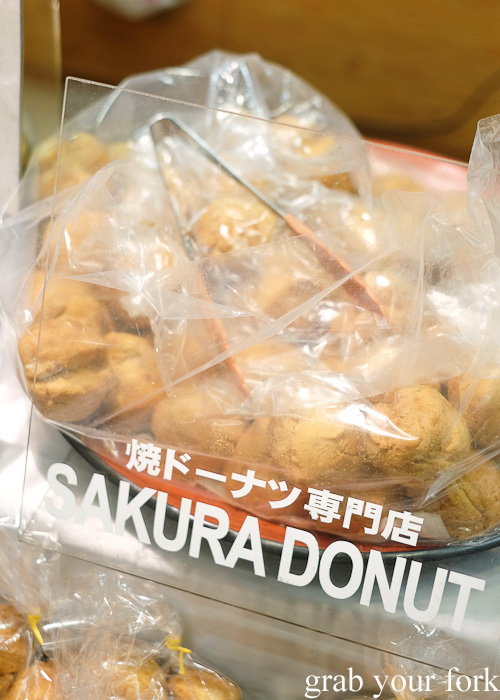
Sakura donuts at Hiroshima station
We only spent a few hours in Hiroshima before making our way back to the station to head to Miyajima Island. We might have raced through the station, but we still spotted the little sakura donuts for sale that somehow made its way into our eager hands.

We'd expected these donuts to have a sakura cherry flavour, much like the soft serves we had in Kanazawa, but sadly these don't have much fragrance or taste at all. They are quite a heavy donut too, almost cake-like in texture, with a thick crust of sugar that scatters everywhere.
Miyajima Island
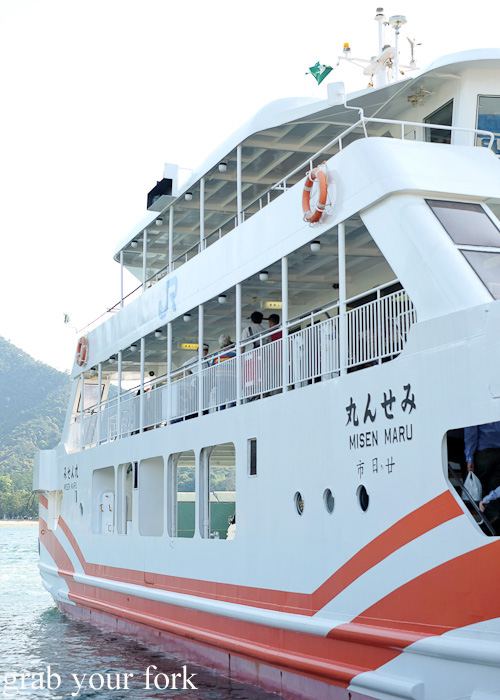
You can get to Miyajima Island for free using your JR pass - just catch the JR ferry from the port outside Miyajimaguchi train station. It takes just ten minutes to get to the island.
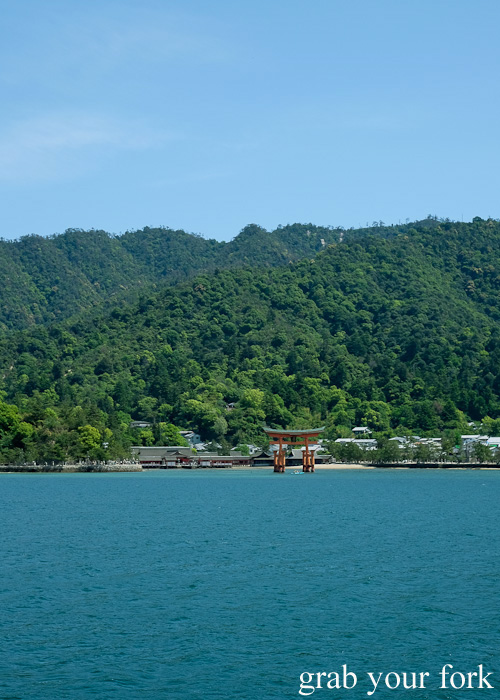
View of Itsukushima Shrine and Miyajima Island from the ferry
The lush green hills of Miyajima Island provide a stunning backdrop for the iconic Itsukushima Shrine.

Wild deer roaming the streets of Miyajima Island
The first thing you'll notice on Miyajima Island are the wild deer freely wandering the streets. They potter through the crowds, mosey their way along shopfronts and are on the constant look-out for food.
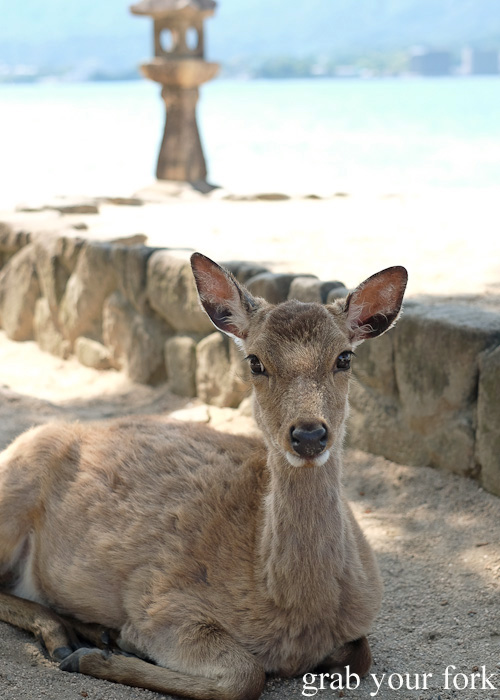
Placid deer
Wild deer are believed to have lived on this tiny island for 6,000 years. As tourists increasingly flocked to the island, feeding them special deer wafers sold on the streets, the deer population exploded and has become increasingly tame.
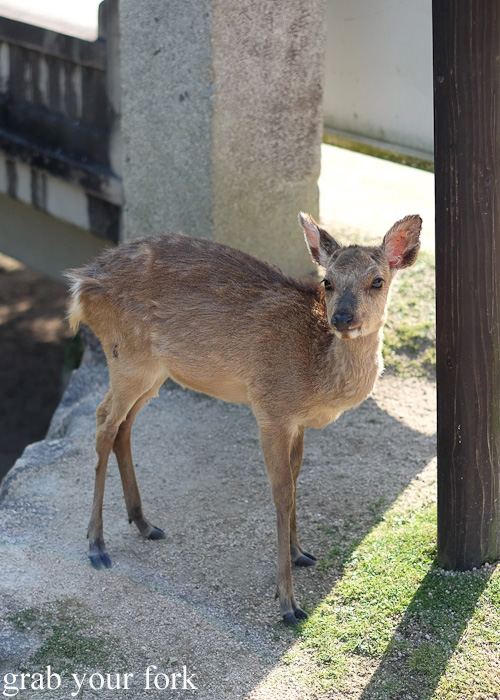
Baby deer
In 2008, Hatsuakichi city officials decided to pass a law banning people from feeding the deer. They hoped this would encourage deer to fend for themselves in the wild and put a natural check on the skyrocketing deer population.

Miyajima deer stalking tourists for food
Critics say that the deer are now too domesticated and unable to forage in the forest anymore. It does explain why the deer are so opportunistic to eat anything, boldly snatching things out of tourists' hands, pockets and bags.
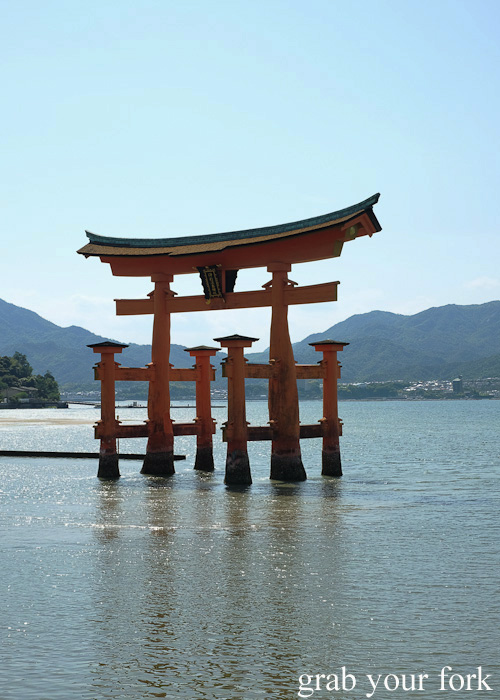
Itsukushima Gate, the floating torii gate at low tide
Tourists haven't always been able to visit Miyajima Island though. For a long period, the island was considered so sacred that noone was allowed to live there. Mount Misen has held particular significance for locals, worshipped by locals since the 6th century.
It's why the Itsukushima torii gate was built out on the water, constructed in 593AD about 200 metres offshore to avoid offending the gods. At high tide, the gate looks like it is floating on water. To this day, noone is allowed to give birth or be buried on the island. There are no hospitals or cemeteries on the island.
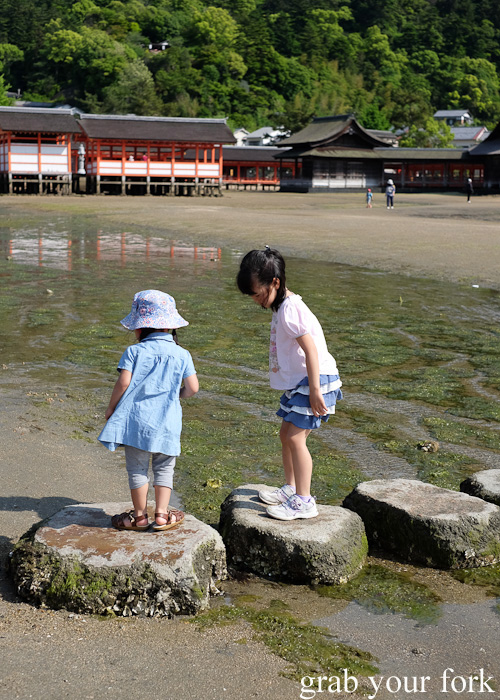
Local kids playing on stepping stones in front of the Itsukushima Shrine
Our visit coincided with low tide meaning we could easily walk up to the Itsukushima Shrine, a series of building built on stilts. During high tide, this shrine looks like it is floating on water, accessed by a series of boardwalks that join the various prayer halls, main hall and noh theatre stage.
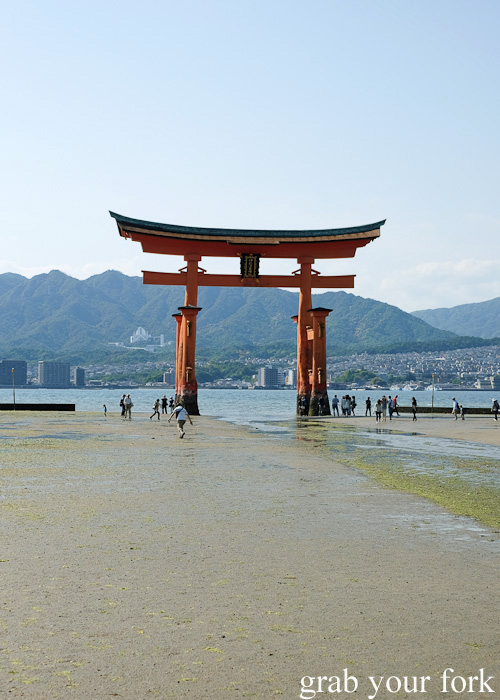
Tourists at the base of Itsukushima Gate at low tide
Low tide also means we can wander around the base of the Itsukushima Gate, really giving a sense of its towering magnitude. The gate is 16 metres tall, built using camphor wood which is known for its strength and resistance to decay.
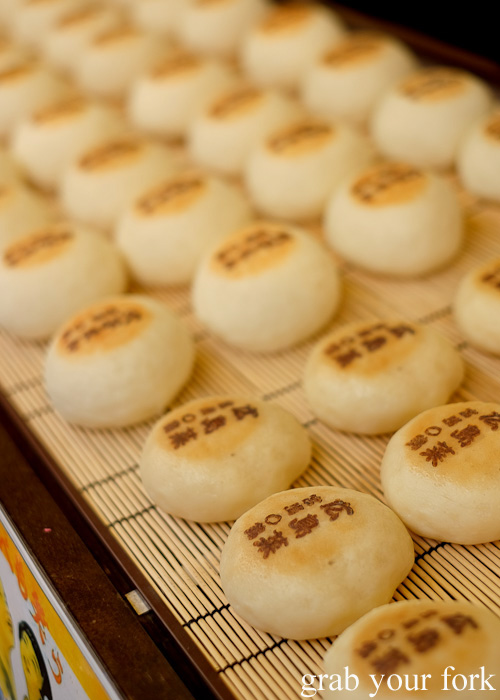
Steamed buns with anago conger eel 430 yen / AU$4.70
The streets of Miyajima Island are filled with tourist shops and food stalls selling everything from Hello Kitty biscuits to grilled oysters to bean-filled buns in the shape of a maple leaf. We find ourselves drawn to the kiosk selling beautiful steamed buns with a stamp on top.
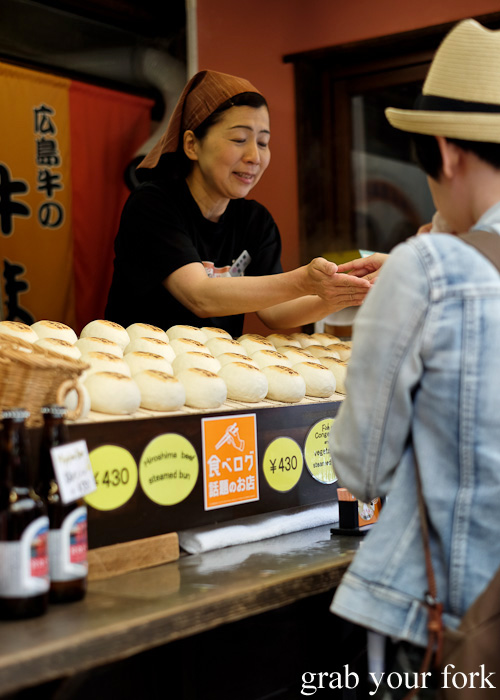
Tourists queueing for steamed buns
The buns come with either Hiroshima beef or anago conger eel and vegetables.

Anago conger eel inside the steamed bun
We can't resist the anago bun, filled with conger eel. Unlike unagi that grows in freshwater, conger eel lives in saltwater and has a milder and less oily flesh. The bun is soft and the filling is piping hot, with an impressive amount of mixture inside the bun.

Nimble deer climbing the mountain cliffs
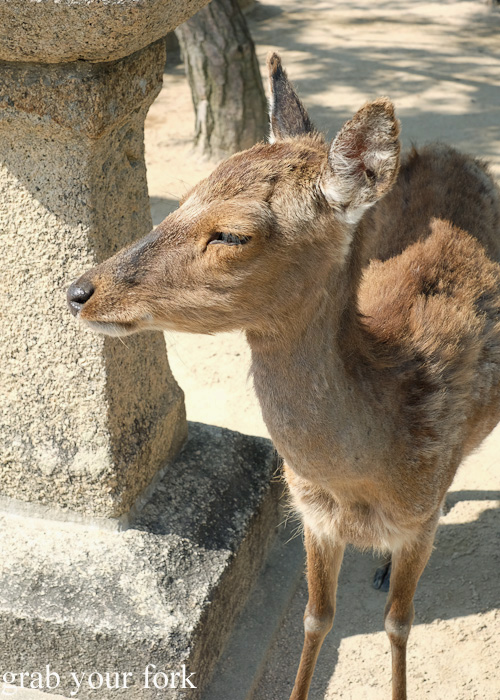
Deer everywhere!
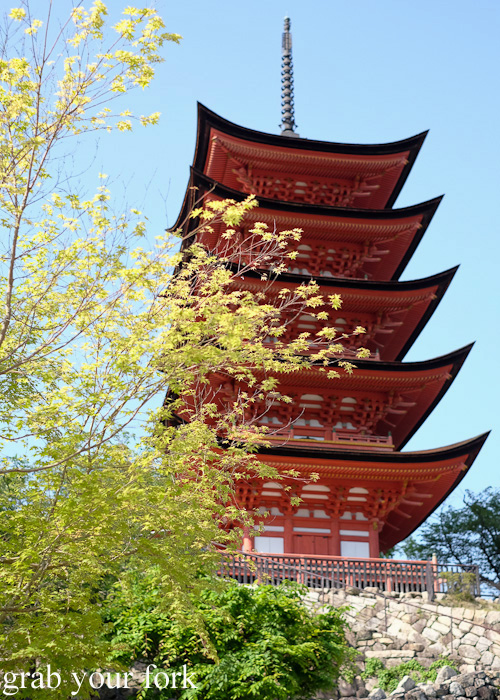
Gojunoto, the 27.6m high five-storey pagoda
We don't embark on any serious bush trails up the mountain, or take the cable car to the peak of Mount Misen - in hindsight I might have if I'd known that macaques are often seen wandering around the top - but we do enjoy a gentle stroll at ground level. We stumble upon Gojunoto, a majestic five-storey pagoda built in 1407 that stands 27.6 metres high. The roof is covered with shingles made from Japanese cypress. Its design combines Japanese and Chinese architectural styles.
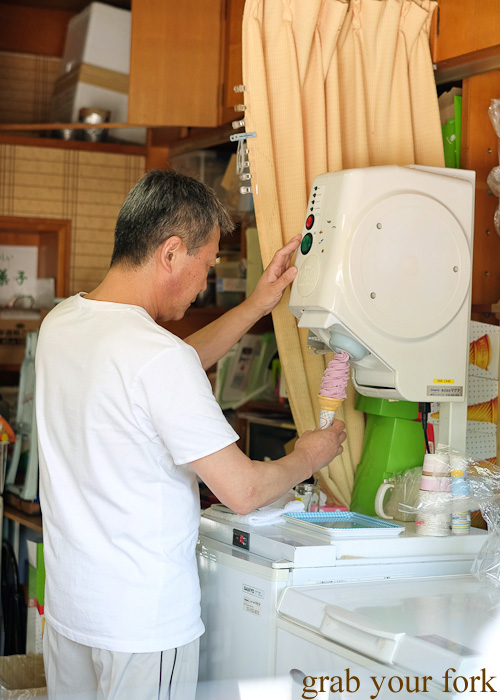
Making my grape soft serve
And of course there was time for a soft serve. It was also the first time we encountered the pre-packed soft serve. A sealed cup containing a frozen flavoured soft serve is inserted into a special machine that enables it to be piped into swirls on a cone.
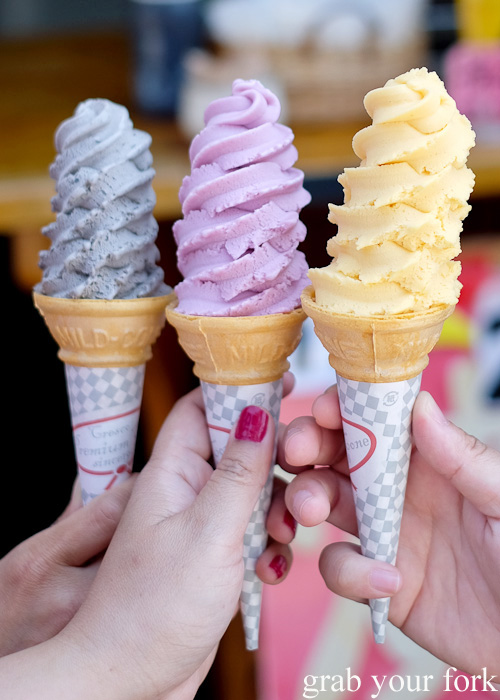
Black sesame, grape and mango soft serves 300 yen / AU$3.30 each
The machine enables the shop to offer a whole rainbow of flavours. Between us, we ordered black sesame, grape and mango soft serves. The texture is more like frozen yoghurt rather than creamy soft serve but they taste delish. My grape soft serve tastes just like Hubba Bubba, and you can't go wrong with that.
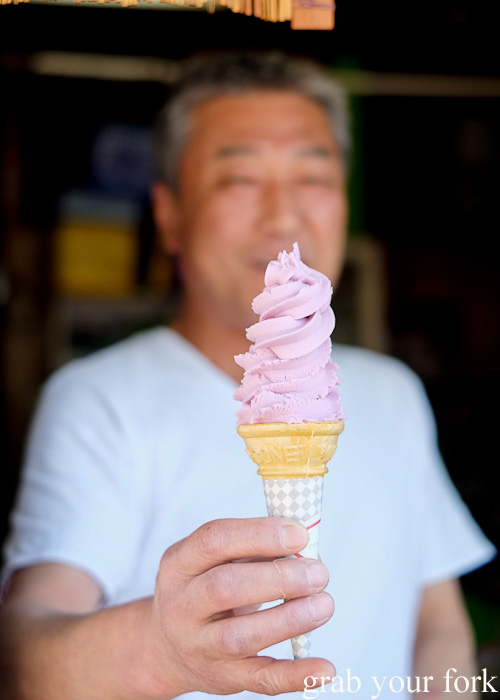
>> Read the next Japan 2015 post: Sapporo Ramen Alley and Hokkaido king crab
<< Read the first Japan 2015 post: Toyama black ramen and firefly squid
Japan 2015: Toyama > Kanazawa > Nagano > Kyoto > Nara > Osaka > Kobe > Kagoshima > Hakata > Hiroshima and Miyajima Island > Sapporo > Otaru > Hakodate > Tokyo
Okonomi-mura
5-13 Shintenchi, Naka-ku, Hiroshima, Japan
posted by Helen (Grab Your Fork) on 8/24/2015 01:06:00 am





15 Comments:
At 8/24/2015 2:57 am, Sarah said…
Sarah said…
Wow, the hiroshimayaki look soooooo good! Putting that on my list for my next trip to Japan!
At 8/24/2015 11:33 am, Hotly Spiced said…
Hotly Spiced said…
I would have had the grape soft serve too. It seems the public transport system in Japan is amazing and also affordable. The deer are just gorgeous but if I'm there, I'll remember to tie down my belongings xx
At 8/24/2015 1:26 pm, Jacq said…
Jacq said…
We had the deer-eating-paper experience when we were on Miyajima as well, when we saw a deer rummaging through a student's schoolbag to emerge munching on some paper! Amusing but no one quite knew what to do about it!
At 8/24/2015 1:28 pm, Martine @ Chompchomp said…
Martine @ Chompchomp said…
I love cheeky animals...I have never heard of document thieving deer though! I would be torn between the frustration of the lost paperwork versus the super cuteness of it all!
At 8/24/2015 2:20 pm, Anonymous said…
Anonymous said…
I love this post! The deer are so beautiful! I have never heard of this place before.
At 8/24/2015 3:03 pm, Unknown said…
Unknown said…
Such a beautiful serene place to be, the deer are beautiful and seem like they are accustomed to the area now.
At 8/24/2015 7:40 pm, Ramen Raff said…
Ramen Raff said…
WHOA!!! That hiroshimiyaki with bacon and those soft serves!!!! Love all your Japan posts Helen!
At 8/24/2015 8:17 pm, irene said…
irene said…
Your Japan posts are killing me, Helen!
At 8/24/2015 10:45 pm, Gareth said…
Gareth said…
Hi Helen, Miyajima Island was one of my trip highlights, I needed you with me though, as I missed the conger eel anago buns.
Love the photos, especially the one of the chap passing you the ice cream. Did you see the mock prorate galleon ferry to the island?
At 8/25/2015 8:39 am, chocolatesuze said…
chocolatesuze said…
lol those cheeky deer!
At 8/26/2015 7:23 am, Chris (Chew Your Chow) said…
Chris (Chew Your Chow) said…
Please tell me you tried the oysters on Miyajima Island!!!
The deer were so lazy until they sensed food when I went haha.
At 8/26/2015 7:36 am, John | heneedsfood said…
John | heneedsfood said…
Ooh I do like the sound of the conger eel. I love unagi but now want to try the saltwater ones. Loving these Japan posts, Helen, don't let them end!
At 8/27/2015 10:21 pm, Tania | My Kitchen Stories said…
Tania | My Kitchen Stories said…
Fascinating Helen. Especially those pancakes. I don't think I would know where to start if I went to Japan
At 9/02/2015 11:55 pm, Sara | Belly Rumbles said…
Sara | Belly Rumbles said…
Loving your Japan posts (always do). Miyajima Island is on my list of have to visit. Haven't been able to quite make it there yet. Hoping to soon.
At 9/10/2015 9:34 pm, Iron Chef Shellie said…
Iron Chef Shellie said…
Oh how I miss Japan! I’m suddenly craving okomoniyaki for some reason ;)
Post a Comment
<< Home